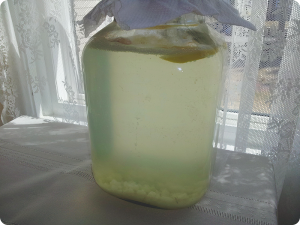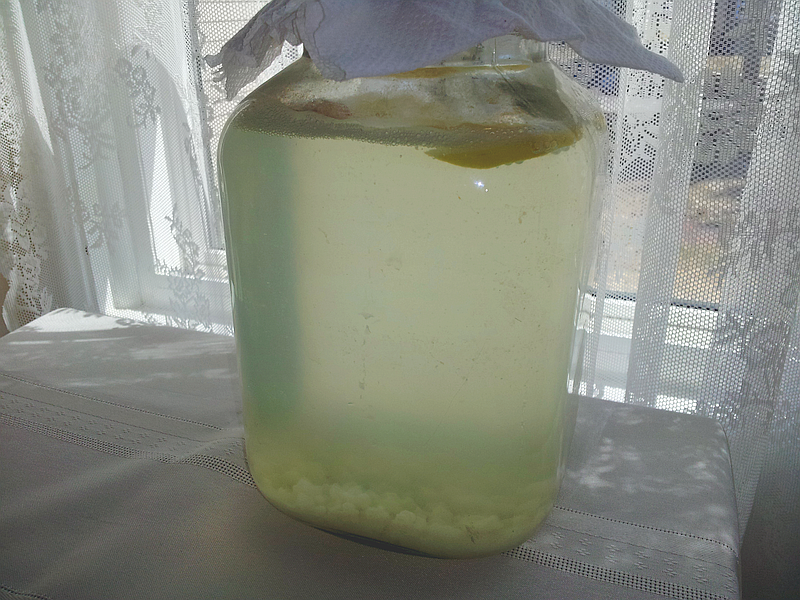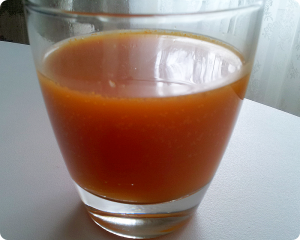Water kefir soda is delicious as it is, and it is healthy, but flavored water kefir is even better because has more nutrients, and it tastes even better. We can use various fruits or fruit juices to flavor it, but we can even use certain aromatherapy plants, or even some therapeutic herbs. We can use the water kefir soda as a base for our healing plants, this method will allow the active ingredients in the fermented plant to be easier absorbed in our bodies, and to get them in a delicious form.
Why Do We Need To Flavor Water Kefir Soda
The flavoring happens on the second fermentation and it serves a few purposes. When I first started making water kefir soda, I saw this as an unimportant step, and I didn’t fully understood why a second fermentation was even necessary. Well, let me tell you this, a second fermentation is not absolutely necessary, but if you compare a soda from the first fermentation and a soda from the second fermentation, you’ll see what I mean.
What is Second Fermentation?
 Second fermentation is the process in which a brew that is close to the fermentation cycle, is reinforced with sugar to restart the fermentation. During this process water kefir soda suffer more transformations, such as enriching in carbon dioxide, (bubbles), make the soda tastier, and tone down some of the undesirable effects of some of the yeasts and bacteria in the brew.
Second fermentation is the process in which a brew that is close to the fermentation cycle, is reinforced with sugar to restart the fermentation. During this process water kefir soda suffer more transformations, such as enriching in carbon dioxide, (bubbles), make the soda tastier, and tone down some of the undesirable effects of some of the yeasts and bacteria in the brew.
There are a few esthetic and organoleptic differences that makes the flavoring almost a must, but the real benefit is with controlling the cultures ratio. The cultures ratio control cannot be performed with the first fermentation, because it will change the symbiosis in the tibicos. It is very important to keep the tibicos, (water kefir grains), composition unchanged, otherwise you either leave place for opportunistic yeast and bacteria to get in, or the new composition, even though it isn’t contaminated, can be less effective, or even give you terrible side effects.
To control the cultures ratio use specific fruit juices, or pulp, or add various prebiotic additives to selectively multiply certain microorganisms in the soda. For instance, we cannot use honey on the first fermentation, because this will change the composition of the kefir grains, killing certain microorganisms. Honey is a great anti-bacterial, so even though it is sweet, its antibacterial properties will weaken your tibicos. On the other hand, some people found they have less stomach problems even when consuming large quantities of soda, if the second fermentation is done with honey.
The soda from the first fermentation is bland, a little tart and sweet, but bland. No color, no flavor, and very little fizz. The second fermentation soda can be the best soda you ever drank in your life. Just use your imagination, you can use anything sweet, and not only. Give the little guys something to chew on, and they’ll make you a delicious drink. The colors are as bright as the juice you are using, so if you need a beautiful soda, just add a little colorful juice.
There is some fizz with the first fermentation, but because the jar needs to be kept open, the fizz will always fade. On the second fermentation, with airtight bottles, all the bubble get locked inside, so your drink can explode because of so much fizziness.
 General Rules for A Second Fermentation
General Rules for A Second Fermentation
- The temperature needs to be range being between 65º – 82ºF (18º – 28ºC).
- The time for fermentation is around 24 hours.
- To get more fizz and less sour, use airtight bottles
- If you add a prebiotic substance/fruit, you will change the initial bacteria an yeasts ratios, an you make it easier on the stomach. I use acacia gum fiber.
- After the fermentation move the bottles in the fridge.
- For lower temperatures, your fermentation will need more time than 24 hours.
- For higher juice/sugar content, you also need more time to completely ferment the juice, and allow the cultures to grow.
What Are the Best Flavors For Water Kefir
I will list you the obvious ones, the ones that everybody love and use, but a few new ones, that you won’t find anywhere else. They are my own recipes, I have experimented a lot with water kefir, and this list contains my favorites.
- Kiwi flavoured water kefir
The recipe is very simple, use a juicer to juice the kiwi fruit, and add 1/4 to 1/3 kiwi fruit juice to soda. Allow to ferment for 24 hours. After 24 hours put it in the fridge, and consume within a couple of days. - Mint Flavored Soda
Put in a blender a bunch of mint, only the leaves, 4-6 spoons of sugar, and a little soda from the first fermentation. Blend well, and put it in a glass bottle, and fill the rest with first fermentation soda. The flavoring should be enough for 2 quarts. This is so good, you won’t be able to stop drinking it, but you have to, otherwise you’ll be sick.  Sea Buckthorn
Sea Buckthorn
If you add some sea buckthorn juice to your brew you get this wonderful orange color, and it is absolutely delicious. If you know a bit about sea buckthorn, you probably know that it is a great aid for liver functions, and a great immunity booster. Combining the natural healing properties of sea buckthorn with the probiotics in your brew makes it probably one of the healthiest sodas on Earth, seriously. But forget about the healing properties, just make some because it tastes absolutely divine. Add 3/4 soda from the first fermentation and 1/4 sea buckthorn berries juice. I like to add the pulp as well, it’s healthier.Ferment for 24 hours and put it in the fridge. Here is a bit more about sea buckthorn health benefits.- Mango flavored water kefir
1/3 mango juice and 2/3 soda from first fermentation. Leave to ferment for 24 hours in a warm environment. This is one of my favorite flavors. - Coconut water kefir
Coconut water kefir is probably one of the most popular sodas made with tibicos. Many people use a first fermentation only recipe for the coconut water kefir, and they just replace thw water and the sugar with coconut water. This is a yummy recipe, and it is great. However, my personal recipe is to use 1/4 first soda from the first fermentation, and 3/4 coconut water. It’s even better than the other recipe. Coconut has antibacterial properties, so adding it to the first fermentation is not wise, since it will modify your culture. - Apple juice flavor
Apple juice is one of my favorites. I add half quantity up to two thirds apple juice, and the rest water kefir soda fermented once. I add 1 tbsb of acacia gum, shake well and let it ferment for about 24 hours, or a bit more. The more it ferments, the more kick it has, as a hard cider. I don’t let it get too strong, but just a bit of alcohol. If I make it so my son can drink it, I let it ferment just 24 hours in a warm room, then I pu it in a fridge. - Ginger Lemon Flavor
For one gallon of soda from the first fermentation add half of cup of lemon juice, you squeeze them freshly, and half a cup grated ginger. Add 1/4 cup sugar, or honey, and let it ferment for 24 hours. Strain and put it in the frigdge. - Berry Flavored Water Kefir
This will work with most of the berries: strawberries, raspberries, blueberries, or blackberries. Add crushed or blended berries – 1/3 of the total quantity. Fill the rest two thirds with water kefir fermented once. Add 1 tablespoon of lemon juice for every quart of the above mix. Ferment for 24 hours, and then put it in the fridge. - Grape Water Kefir
Grapes flavored kefir is probably one of the best tasting ones. It reminds me of the fall/harvesting time in my native Romania, when all the farmers press fresh grapes, and make the must. I must have drunk gallons of must, some just freshly pressed, as a juice, some a little fermented, and this is the best one. So for this recipe, I must tell you, there are no definite rules, I tried various ratios of grape juice to water kefir, and they all work great. My favorite would be 3/4 grape juice freshly pressed to 1/3 water kefir. This allows a stronger grape taste, and enough fermenting agents. Buy fresh grapes, or frozen. I personally, don’t like the pasteurized juice, but it is more convenient to use it. The pasteurization kills the enzymes in the fruit. When you buy grapes, look for wine grapes, they are more jucy, and they have a nice flavor. You can also ferment the pomace too, that allows extra flavors to be extracted, you just have to strain before moving it into bottles and tranfer to the fridge. If your grapes are not sweet enough, add some sugar. Because you only add 1/3 fermenting agent, it might take slightly longer to fully ferment. Starting from your 24 hours mark, taste it every 6 hours or so. Remember, this is not your regular yeast fermentation, so do not compare it with wine making… - Grapefruit Flavor
Squeeze freshly the juice o one big grapefruit, add 2 tablespoons sugar, and 1 quart first fermentation soda. Mix the sugar in the soda so it dissolves properly, add the grapefruit juice, and let it ferment in airtight bottles for 24 hours or so. After 24 hours drink, or transfer in the fridge. - Orange Blast Water Kefir
This is a recipe that uses flavors from both the orange juice and the zest. For this recipe you need the juice from three ripe oranges and the zest of one or two. Use organic oranges, so you can use the zest. Add the juice, the zest, and 1 quart of water kefir f.f. and ferment for 24 hours to 48 hours, after which transfer it to the fridge. If the oranges are not sweet, you can add two tbsp sugar. Use a strainer when you pour in glasses.

 General Rules for A Second Fermentation
General Rules for A Second Fermentation Sea Buckthorn
Sea Buckthorn
Xylitol and Water Kefir Soda
Can you use Xylitol to sweeten the Water Kefir Soda? If so, when do you add it?
Xylitol and Water Kefir Soda
Dee, thanks for reading.
I wrote an article on this here: http://goo.gl/Qh6nhQ.
You can add xylitol for the second fermentation. I tried it once, and I believe that it reduces drastically the diversity of microbes in the soda. Very few of the microorganisms in the tibicos can adapt and feed on the xylitol. This means the benefits of drinking it are minimized.
Don’t use it during the first fermentation, it will destroy your culture, since most of the microbes in the culture will starve on xylitol.
No fizz after second fermentation
Dee, in our second fermentation we add ginger and lemon, for a juices. Four lemons and four thumbs of ginger for a gallon, after 48 hrs no fizz or very little fizz. The grains have been strained and put in new batch – the bubbles and strong and the grains look like they are multiplying. Thoughts
more fizz tips
I have been making kefir water for some time now. I haven’t been getting as much fizz as I’d like and will try some of your ideas to increase my fizz and taste. Thanks for all the tips.
more fizz tips
Thanks for taking the time to comment Cindy. Let us know your results.
when putting in the swing top
when putting in the swing top bottles it makes all the difference in it being fizzy or not
Grains
Can kefir grains form in the second fermentation? Several of my recent batches that have sat for around 48 hours have what look like small grains forming on the bottom of the jar. Just curious if that is actually what it is, and if I can then add them to my original grains to grow my supply?
Adding acacia gum fiber
How much acacia gum fiber do you add to water kefir for 2nd fermentation?
Fizzy kefir
I learned from kombucha making that a 1/4 broken egg shell that has been baked at 200° F for 10 (min) to guard against salmonella.etc., added to a 16 oz bottle during 2ndF…the minerals, esp.calcium carbonate, in the egg shell combines with the tibicos acids produced by the first feement, and voilà…tons of fizz. And agree and attest….flip top bottles are a must. Screw tops definitely prone to leakage!
Berry Good
Dorian, thank you for all the details, ideas, and encouragement. Also to all who comment- it fosters community feel and understanding. Kefir and other time-honored cultures help harmonize CULTURE inside and outside ourselves : )
I’m creating a second fermentation with the four kinds of mentioned berries, lightly crushed. Will add lemon juice after it’s done on the counter, but before refrigerating, as I am not sure if it is a great acid to add while fermenting.